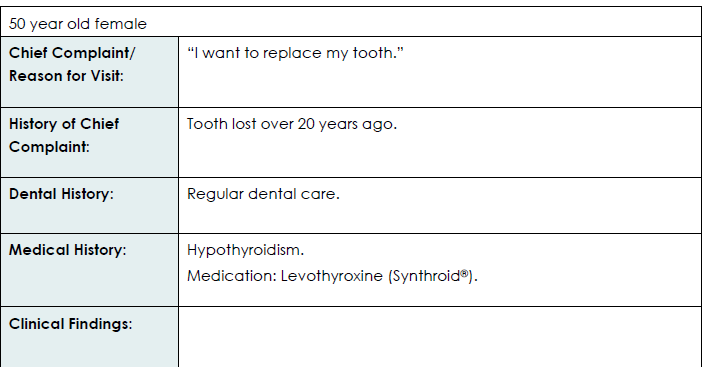Decoding Case Histories in the NDEB Virtual OSCE
by Dr. Laura Nguyen | Published: April 07, 2025

In the NDEB Virtual Objective Structured Clinical Examination (OSCE), case-based questions often hinge on a patient case history—a snapshot of a patient’s background and clinical details. Understanding how these histories are structured can give candidates a leg up in analyzing scenarios and answering questions accurately. Let’s break down a typical case history and its role in the exam.
A standard case history follows a clear format. Here’s an example:
50-year-old female
Chief Complaint/Reason for Visit: ‘I want to replace my tooth.’
History of Chief Complaint: Tooth lost over 20 years ago.
Dental History: Regular dental care.
Medical History: Hypothyroidism.
Medication: Levothyroxine (Synthroid®).
Clinical Findings: [General information about the patient will be in the top row.]
This layout provides the essentials: who the patient is, why they’re there, and what’s relevant from their past and present health.
The case history table is designed for efficiency. Empty cells—like in the Clinical Findings section—mean there’s nothing significant to report. Below the table, you might find clinical images, dental charts, radiographs, or 3D models to enrich the scenario. These visuals are critical for questions requiring diagnosis or treatment planning.
Some cases include a periodontal chart for a few teeth, accompanied by a note: ‘This area reflects the overall periodontal condition of this patient.’ This signals that the chart isn’t just a detail—it’s a key to understanding the patient’s broader oral health. For our 50-year-old patient, you might see a chart showing stable gums thanks to her regular dental care, influencing your approach to replacing that missing tooth.
Take the example above: a woman with hypothyroidism, on Levothyroxine, wants a tooth replaced after 20 years. A question might ask about treatment options—say, a dental implant. You’d need to consider her medical history (is her condition controlled?), her long-term tooth loss (bone resorption?), and clinical findings (any images showing jaw structure?). The case history ties it all together.
The value of these case histories lies in their realism. They mimic the patient encounters you’ll face in practice, where every detail—from a medication to a missing tooth—shapes your decisions. In the Virtual OSCE, they test your ability to synthesize information quickly and apply it to multiple-choice or short-answer questions.
To prepare, practice reading case histories like this one and connecting the dots. Pair them with sample images or charts from the NDEB’s Virtual OSCE Frameworks. The more you get used to this format, the better you’ll handle the roughly 150 case-based questions on exam day. It’s all about seeing the patient behind the data.